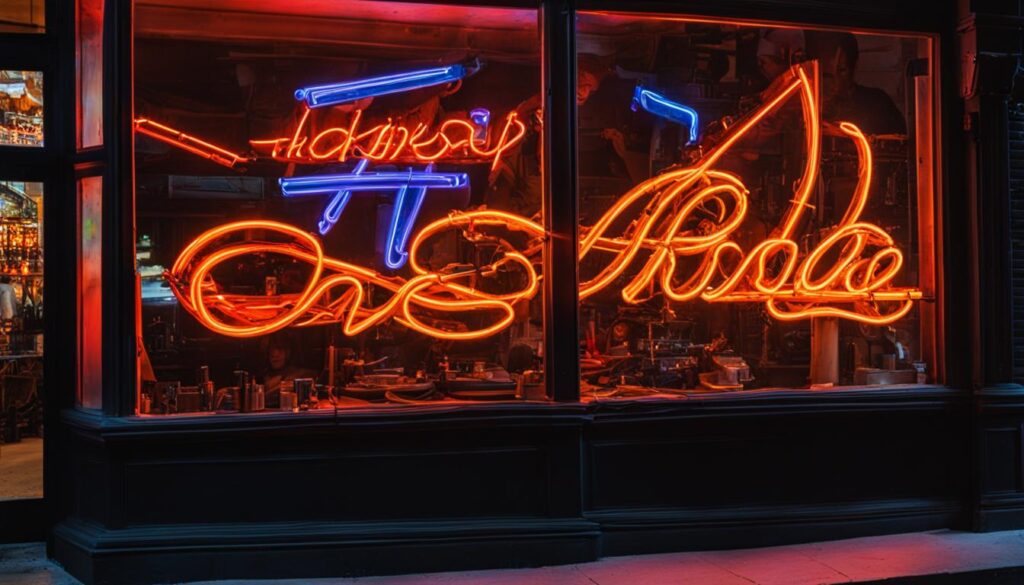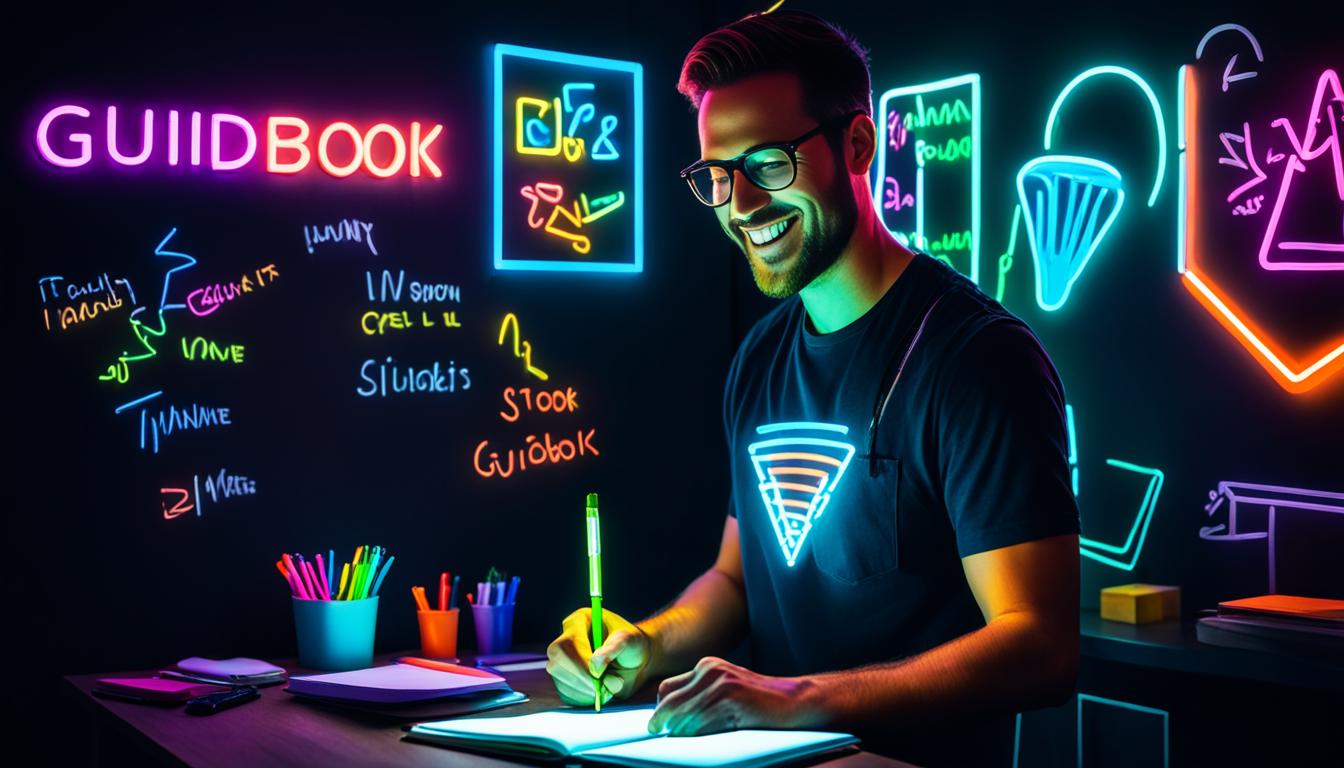Are you passionate about creativity and entrepreneurship? Starting a neon sign business can be a profitable venture that allows you to unleash your artistic talents while running your own company. Whether you dream of crafting neon signs for businesses, bars, or even weddings, this comprehensive guide will provide you with the essential steps to start a successful neon sign business from scratch. By the end, you’ll have the knowledge and confidence to embark on your neon sign business journey.
Key Takeaways:
- Starting a neon sign business offers a lucrative opportunity to express your creativity and run a profitable venture.
- Understand the differences between traditional and LED neon signs to determine which type aligns best with your business goals.
- Designing a neon sign involves considering factors such as size, colors, and mounting options.
- Getting a quote from a neon sign company based on your design idea is an important step before finalizing the production process.
- Producing neon signs involves machining, painting, fitting LEDs, quality control, and packaging.
Understanding the Difference Between Traditional and LED Neon Signs
Before diving into the process of starting a neon sign business, it’s important to understand the differences between traditional and LED neon signs. Traditional neon signs are made with glass neon tubing, require more power to run, and can be hot to the touch.
LED neon signs, on the other hand, are made with acrylic neon tubing, are energy-efficient with lower running costs, and have a cool touch.
Let’s take a closer look at the pros and cons of both types of neon signs:
- Traditional Neon Signs:
- Pros:
- Classic and vintage aesthetic
- Bright and vibrant colors
- Wide range of design possibilities
- Durable and long-lasting
- Cons:
- Higher energy consumption
- Requires more maintenance
- Runs hot, posing potential safety risks
- Costlier installation
- Pros:
- LED Neon Signs:
- Pros:
- Energy-efficient and cost-effective
- Cool to the touch, ensuring safety
- Greater flexibility in design and customization
- Lower maintenance requirements
- Cons:
- May lack the nostalgic charm of traditional neon signs
- Limited color options compared to traditional neon signs
- Pros:
Consider the pros and cons of traditional and LED neon signs to determine which type best aligns with your business goals and target market. Whether you prefer the timeless appeal of traditional neon signs or the energy-saving benefits of LED neon signs, both options provide captivating and eye-catching signage solutions for your neon sign business.
Designing Your Neon Sign
The first step in starting a neon sign business is designing the sign itself. Whether you have a specific idea in mind or need the assistance of a graphic designer, the design of your neon sign plays a crucial role in attracting customers and reflecting your brand identity.
When designing your neon sign, there are several considerations to keep in mind. The size of the sign should be proportional to its intended placement, ensuring it catches the attention of passersby without overwhelming the space. Consider the color palette carefully, as vibrant and eye-catching colors can enhance the visual impact of your sign.
The choice of a backboard or mounting is another important consideration. A well-selected background can accentuate the neon glow and provide a stylish backdrop for your sign. Common options include acrylic, metal, or wood backboards, each offering a different aesthetic appeal.
For those seeking a more versatile option, faux neon signs are worth considering. These signs replicate the appearance of traditional neon signs but are made using LED lighting instead. Faux neon signs offer customization options such as flashing, color-changing, and dimming features, allowing you to create dynamic and captivating displays.
Remember, the design of your neon sign is an opportunity to showcase your creativity and make a lasting impression on potential customers. Take the time to explore different design options, experiment with color combinations, and choose the right backboard or mounting to create a custom neon sign that truly represents your brand.

Getting a Quote and Finalizing the Design
Now that you have your design idea for your neon sign, it’s time to get a quote and finalize the details. To start the process, simply email your design idea to the neon sign company of your choice. Make sure to provide them with all the necessary details, including the size, colors, and preferred mounting options.
The company’s team of experienced designers will then create artwork based on your idea and calculate the cost for you. Whether you’re interested in acrylic neon signs or glass neon signs, they will provide you with a quote that suits your specific needs.
It’s important to note that the costs for acrylic neon signs and glass neon signs are similar. However, if you’re looking for outdoor signs, you may find that LED neon displays are slightly less expensive than their traditional counterparts.
Once you receive the quote, you can review it and, if everything meets your expectations, approve it to move forward with the production process.
Getting a quote and finalizing the design is a crucial step in starting your neon sign business. It ensures that you have a clear understanding of the costs involved and allows you to make informed decisions before proceeding.
Production Process for Neon Signs
Producing neon signs involves several stages that require expertise in different departments. To ensure a high-quality end product, each step of the production process must be executed with precision. Here is a breakdown of the stages involved in creating neon signs:
1. Machining the Acrylic and Backings
Firstly, the acrylic tubes and backings are carefully machined to the required specifications. This process involves cutting, shaping, and preparing the materials that will form the foundation of the neon sign design.
2. Painting or Applying Vinyl
Next, the acrylic tubes and backings are either painted or covered with vinyl. Painting allows for customized colors and finishes, while applying vinyl can provide intricate designs and graphics.
3. Fitting LEDs
After the acrylic and backings are prepared, low-voltage LEDs are fitted inside the acrylic tubing. These LEDs will illuminate the sign and create the neon effect.
4. Final Assembly
The next step involves the final assembly of the neon sign. The acrylic tubes with LEDs are mounted on the backing board according to the design specifications. This ensures that the sign is structurally sound and ready for use.
5. Quality Control
Quality control is an essential part of the production process. Each neon sign undergoes a three-hour testing phase to ensure that all components are functioning correctly and the sign meets the highest standards of quality and safety.
6. Packaging
Once the neon sign has passed quality control, it is carefully packaged for delivery or collection. Adequate packaging is crucial to protect the sign during transit and ensure its safe arrival at its final destination.
The duration of the production process can vary depending on the complexity of the design, but it typically takes around 10 days from start to finish. By following these meticulous steps, neon sign manufacturers can deliver stunning, custom-made signs that captivate customers and enhance their businesses.

Delivery and Installation of Neon Signs
Once your neon sign is ready, it will be safely delivered to your location. Depending on where you’re located, delivery times may vary. We understand the excitement of receiving your custom neon sign, and we strive to ensure a seamless and timely delivery process.
When it comes to installation, LED neon signs have a clear advantage. Unlike traditional neon signs, LED neon signs do not require a fire switch installation. This is because LED neon signs are powered by low-energy LEDs, eliminating the need for additional electrical requirements. The absence of a fire switch not only simplifies the installation process but also reduces installation costs.
Additionally, LED neon signs are easier to install compared to traditional neon signs. Unlike their glass counterparts, LED neon signs are made with acrylic neon tubing, which is lightweight and can be mounted in various ways. This means that you won’t need to hire a specialist contractor for installation, saving you time and money.
LED neon signs offer numerous benefits, including energy efficiency and easy installation, making them popular choices for businesses of all sizes. Whether you’re a small boutique, a trendy restaurant, or a thriving bar, LED neon signs can enhance your establishment’s branding and visibility.
Benefits of LED Neon Signs:
- Energy efficiency: LED neon signs consume less energy compared to traditional neon signs, helping you save on energy costs in the long run.
- Versatility: LED neon signs offer a wide range of colors and lighting effects, allowing you to create eye-catching and vibrant designs.
- Durability: LED neon signs are highly durable and resistant to breakage, making them suitable for both indoor and outdoor installations.
- Longevity: LED neon signs have a longer lifespan compared to traditional neon signs, reducing the need for frequent replacements.
- Easy maintenance: LED neon signs require minimal maintenance, allowing you to focus on other important aspects of your business.
With their easy installation, energy efficiency, and versatility, LED neon signs are the perfect choice for businesses looking to make a statement. Let your creativity shine with a custom LED neon sign that reflects your brand’s personality and captures the attention of your target audience.
Business Plan for Your Neon Sign Business
Before launching your neon sign business, it’s important to develop a comprehensive business plan. Creating a business plan allows you to outline your goals, identify your target market, analyze your competition, and project your financials. It serves as a roadmap for your business and provides a solid foundation for success.
Writing a business plan can seem daunting, but there are resources available to help you through the process. Online guides, templates, and business plan software can provide structure and guidance. These resources can assist you in organizing your ideas, conducting market research, and crafting a professional plan that showcases the potential of your neon sign business.
One crucial aspect of developing your business plan is evaluating your competitors. Understanding their strengths, weaknesses, and market positioning can give you valuable insights into what sets your business apart and how to effectively compete in the industry. By studying your competitors, you can identify gaps in the market and capitalize on opportunities.
Seeking advice from experienced neon sign business owners can also be invaluable. Connecting with industry professionals who have successfully navigated the challenges of starting a neon sign business can provide you with valuable insights and real-world advice. Online forums, networking events, and mentorship programs are great avenues to find remote business advice and guidance from those who have walked the same path.
When considering your business plan, it’s worth exploring the potential benefits and drawbacks of acquiring an existing neon sign business. Acquisitions can offer established customer bases, operational efficiencies, and valuable assets. However, they also come with their own set of challenges, such as integrating existing systems and managing potential risks. Assessing the pros and cons can help you make an informed decision that aligns with your goals.
For those looking for a faster route to market, franchising may be worth considering. Franchising offers a proven business model, established brand recognition, and ongoing support from the franchisor. However, it’s essential to carefully evaluate the terms and conditions of the franchise agreement and ensure it aligns with your vision for your neon sign business.
The business plan for your neon sign business serves as a blueprint for success. By taking the time to write a comprehensive plan, evaluating competitors, seeking remote business advice, and considering different startup approaches, you can set yourself up for long-term success in the neon sign industry.

Networking and Mentorship in the Neon Sign Industry
Building a network and finding a mentor in the neon sign industry can greatly benefit your business. Networking allows you to connect with other professionals, share knowledge, and learn from experienced individuals. By connecting with industry professionals, you can gain valuable insights, find new opportunities, and establish mutually beneficial relationships.
To expand your network, seek out industry events, trade shows, and conferences related to the neon sign industry. These events provide excellent opportunities to meet fellow industry professionals, share ideas, and learn about the latest trends and innovations. Additionally, consider joining online communities and forums dedicated to the neon sign industry. These platforms allow you to connect with professionals from around the world, exchange information, and stay updated on industry news.
Finding a mentor is an invaluable resource for your neon sign business. A mentor can provide guidance, share their expertise, and offer valuable insights based on their years of experience in the industry. To find a mentor, reach out to established neon sign business owners, attend industry conferences, and utilize online platforms that facilitate mentorship connections.
When connecting with potential mentors, communicate your eagerness to learn and ask thoughtful questions. Show genuine interest in their experiences and seek advice on specific challenges you’re facing in your neon sign business. Remember, mentorship is a two-way street, so be prepared to offer your own expertise and contribute to the mentor-mentee relationship.
By building a strong network and finding a mentor in the neon sign industry, you can enhance your knowledge, expand your business opportunities, and increase your chances of success. Embrace the power of networking and mentorship to fuel your growth in the vibrant world of neon signs.
Marketing and Growing Your Neon Sign Business
To grow your neon sign business, it is essential to have a strong marketing strategy in place. Effectively marketing your neon sign business will help you attract more customers and establish a reputable brand presence. Here are some key strategies to consider:
Create a Compelling Brand Identity
Developing a compelling brand identity is crucial for setting your neon sign business apart from competitors. Define your unique selling points and craft a brand story that resonates with your target audience. A strong brand identity builds trust and loyalty among customers.
Build an Online Presence
In today’s digital age, having an online presence is crucial for success. Create a professional website that showcases your work, services, and contact information. Utilize social media platforms like Facebook, Instagram, and Pinterest to showcase your neon sign designs and engage with potential customers. Regularly update your online profiles to stay relevant and visible.
Utilize Social Media Marketing
Social media marketing is a powerful tool for reaching a wider audience and generating leads. Create engaging content that highlights the benefits of neon signs and their applications. Use visually appealing images and videos to showcase your work and attract attention. Engage with your followers by responding to comments, running contests or giveaways, and sharing customer testimonials.
Consider Collaborations
Collaborating with other businesses or influencers can help expand your reach and attract new customers. Look for complementary businesses or individuals in related industries who share your target audience. Partnering for joint promotions or sponsored content can create synergistic benefits and increase your visibility in the market.
Harness the Power of Customer Testimonials
Customer testimonials are a powerful marketing tool that builds trust and credibility. Encourage your satisfied customers to provide testimonials through reviews and ratings. Share these testimonials on your website, social media platforms, and promotional materials to showcase the quality of your work and the positive experiences of your customers.
By implementing effective marketing strategies, you can significantly grow your neon sign business and establish a strong presence in the market. Continuously refine and adapt your marketing efforts to stay ahead of the competition and attract new customers.
Conclusion
Starting a neon sign business requires careful planning, creativity, and dedication. By following the step-by-step process outlined in this guide, you can successfully start and grow your own neon sign business.
Understanding the differences between traditional and LED neon signs, designing unique and eye-catching signs, and ensuring high-quality production are all crucial steps in building a successful neon sign venture. Additionally, effective marketing and continuous adaptation to industry trends will help you stay ahead in the competitive market.
With perseverance and a passion for neon signs, you have the opportunity to ignite your entrepreneurial spirit and create a luminous success. Remember to stay true to your brand, provide exceptional customer service, and consistently deliver high-quality neon signs that leave a lasting impression on your customers. Now, it’s time to turn your neon sign business dreams into a brilliant reality!
FAQ
What are the differences between traditional and LED neon signs?
Traditional neon signs are made with glass neon tubing and can be hot to the touch, while LED neon signs are made with acrylic tubing and have a cool touch. LED neon signs are also more energy-efficient and have lower running costs compared to traditional neon signs.
How do I design a neon sign?
You can either come up with your own design or work with a graphic designer to create a design for your neon sign. Consider factors such as size, colors, and mounting options, and explore the various customization options available with LED neon signs.
How can I get a quote for a neon sign?
Email your design idea to a neon sign company and provide them with details such as size, colors, and mounting preferences. The company’s designers will create artwork based on your idea and provide a quote for the neon sign.
What is the production process for neon signs?
The production process includes machining the acrylic and backings, painting or applying vinyl, fitting LEDs inside the acrylic tubing, final assembly on the backing board, quality control testing, and packaging for delivery or collection.
How are neon signs delivered and installed?
Neon signs are delivered to your location, and LED neon signs can be easily installed without the need for a specialist contractor. LED neon signs do not require a fire switch installation, making the process simpler and more cost-effective.
How should I develop a business plan for my neon sign business?
A comprehensive business plan should outline your goals, target market, competition, and financial projections. You can find resources to help you with the business plan writing process and consider seeking advice from experienced neon sign business owners.
How can networking and mentorship benefit my neon sign business?
Networking allows you to connect with other professionals, share knowledge, and learn from experienced individuals in the neon sign industry. Finding a mentor can provide valuable guidance and insights to help you navigate the challenges of starting and growing your neon sign business.
How can I market and grow my neon sign business?
Develop a compelling brand identity, create an online presence through a professional website and social media platforms, and utilize social media marketing to reach a wider audience. Collaborations with other businesses or influencers and customer testimonials can also help expand your reach and build trust in your work.
What are the key steps to starting a neon sign business?
The key steps to starting a neon sign business include understanding the differences between traditional and LED neon signs, designing your neon sign, getting a quote and finalizing the design, overseeing the production process, ensuring proper delivery and installation, developing a business plan, networking and seeking mentorship, and implementing an effective marketing strategy.




